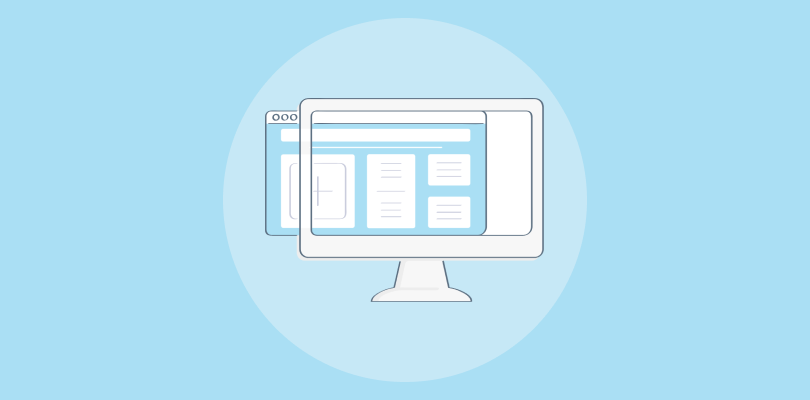“Loyalty cannot be blueprinted…it is a force which leaps into being only when conditions are exactly right for it – and it is a force very sensitive to betrayal.” – Maurice Franks
With the majority of a business’s revenue depending on how loyal its customers are, brand loyalty is a metric one can seldom afford to go without measuring regularly. Till now, Net Promoter Score has remained the best way to do it.
Before delving into it, let’s see how brand loyalty works.
If you search for the best earpods in the market, chances are, you’d find Apple in the top recommendations. There are numerous brands offering similar items, and yet, Apple’s launch creates a buzz that draws in even the one unversed in its merchandise to make a purchase.
The result? The brand acquires a new customer base as well as an active promoter.
NPS is the yardstick that measures exactly what percentage of your customers are likely to act as your promoters, remain passive, or actively detract from your brand reputation by speaking negatively about you.
In this guide, we’ll explore NPS in detail – what it is, how it’s measured, the various types of NPS surveys, as well as expert-driven tips on improving your NPS score for a more successful business.
The path to customer loyalty starts here, so let’s dive in and unleash the power of NPS surveys together!
What is Net Promoter Score (NPS)?
Net Promoter Score (NPS) is a gold standard customer loyalty metric that measures the willingness of customers to recommend a brand, product, or service to others.
It is based on a simple question: “On a scale of 0-10, how likely are you to recommend [brand/company] to a friend or colleague?”
To understand NPS, let’s break it down into three key components:
Promoters: Customers who respond with a rating of 9 or 10 are considered promoters. These individuals are highly satisfied with their experience and are enthusiastic about recommending the brand to others. Promoters are crucial for driving positive word-of-mouth and are likely to become loyal, repeat customers.
Passives: Customers who respond with a rating of 7 or 8 fall into the passive category. They are generally satisfied but not overly enthusiastic or likely to actively promote the brand. Passives may continue using the product or service but are more susceptible to competitive offers.
Keep in mind that customers may be at different stages of their journey. It’s important to identify the points where you can transform passive customers into enthusiastic promoters by offering value to them.
Detractors: Customers who respond with a rating of 0 to 6 are detractors. These individuals are dissatisfied or had a negative experience and are more likely to share their negative opinions with others.
Detractors need particular care while tending to because they can potentially harm a brand’s reputation and customer acquisition efforts.
It may be disheartening, but remember, they are also your biggest opportunity to learn where you can improve and get ahead!

How to Calculate Net Promoter Score
Calculating Net Promoter Score (NPS) involves a simple formula that uses the percentage of promoters and detractors among survey respondents. Here’s a step-by-step guide to calculating NPS:
a. Collect survey responses: Distribute an NPS survey that includes the key question: “On a scale of 0-10, how likely are you to recommend [brand/company] to a friend or colleague?” Ensure that respondents provide a numerical rating.
b. Categorize respondents: Segment survey respondents into three groups based on their ratings:
Promoters: Those who rate 9 or 10
Passives: Those who rate 7 or 8
Detractors: Those who rate 0 to 6
c. Calculate percentages: Determine the percentage of respondents in each category by dividing the number of respondents in that category by the total number of respondents and multiplying by 100.
d. Calculate NPS: Subtract the percentage of detractors from the percentage of promoters. The formula is:
NPS = % Promoters – % Detractors
For example:
Let’s say you received 200 survey responses, with 120 promoters (rating 9 or 10) and 40 detractors (rating 0 to 6). The calculation would be as follows:
Percentage of Promoters = (120 / 200) * 100 = 60%
Percentage of Detractors = (40 / 200) * 100 = 20%
NPS = 60% – 20% = 40
In this example, the NPS would be 40, indicating a positive NPS score.
The higher the NPS, the more positive the customer sentiment and likelihood of customer recommendations.
The NPS score can also be calculated using a 5-point scale. In this case, customers are asked to rate their likelihood of recommending a business on a scale of 1-5, with 1 being “Not at all likely” and 5 being “Extremely likely.” The NPS score is then calculated by subtracting the percentage of customers who gave a rating of 1 or 2 from the percentage of customers who gave a rating of 4 or 5.
Watch: How to Calculate Net Promoter Score
Why Is NPS Important?
Understanding the significance of Net Promoter Score (NPS) is crucial for driving customer loyalty and propelling your business to new heights. NPS serves as a powerful tool that goes beyond simple customer satisfaction metrics. It provides valuable insights into customer sentiments, enabling you to make informed decisions to enhance your products, services, and overall customer experience.
Let’s delve into the benefits of NPS, the link between NPS and customer loyalty, and how NPS can serve as a key performance indicator (KPI) for your business.
Benefits of NPS for Businesses:
Implementing NPS yields a multitude of advantages for your business. By measuring customer loyalty and advocacy, you gain insights that can drive meaningful improvements. NPS surveys provide actionable feedback, enabling you to:
- Identify Areas for Improvement: NPS helps pinpoint specific pain points in the customer journey. By analyzing customer comments and suggestions, you can address weaknesses, refine processes, and optimize customer experiences.
- Foster Customer-Centric Culture: NPS encourages a customer-centric mindset throughout your organization. With a clear focus on customer feedback and satisfaction, your teams can align their efforts to deliver exceptional products and services that resonate with your customers.
- Enhance Customer Retention: Happy customers are likelier to stay loyal and continue doing business with you. NPS helps you identify satisfied customers who can become brand advocates, driving positive word-of-mouth and reducing customer churn.
Link Between NPS and Customer Loyalty:
Numerous studies have demonstrated a strong correlation between NPS and customer loyalty. According to research, loyal customers who are promoters tend to:
- Make repeat purchases: On average, promoters are more likely to remain loyal and increase their spending with a brand, contributing to higher customer lifetime value.
- Refer others: Promoters act as brand ambassadors, sharing positive recommendations with their friends, family, and colleagues. A satisfied customer is a powerful marketing asset.
- Provide valuable feedback: Promoters often offer constructive feedback and suggestions for improvement, enabling you to refine your offerings and stay ahead of competitors continuously.
NPS as a Key Performance Indicator (KPI):
Net Promoter Score (NPS) is a widely used key performance indicator (KPI) that measures customer loyalty and satisfaction. It provides organizations with valuable insights into customer sentiment and can help gauge the overall health of their customer relationships. Here’s how NPS works as a KPI:
- Benchmarking: Organizations can use NPS to benchmark their performance over time. An increasing NPS suggests that customer loyalty and satisfaction are improving.
- Comparison: NPS allows companies to compare their performance with industry benchmarks or competitors. It helps identify where they stand in relation to others.
- Root Cause Analysis: If NPS decreases, companies can use this as a KPI to investigate the reasons behind customer dissatisfaction. By identifying and addressing these issues, they can improve customer loyalty.
- Customer-Centric Focus: NPS encourages organizations to focus on improving customer experiences and building stronger relationships with customers. It aligns the company’s goals with customer satisfaction.
How to Create an NPS Survey
Creating NPS surveys is actually quite easy – in fact, if you use free templates that many tools, including ours, offer, the process is essentially almost done for you. However, you should consider how you will use the data in the long run when choosing how to conduct the surveys.
You could use survey software, but that will limit your ability to act on the results because it only measures one metric. We suggest using a Customer Experience Management Platform or NPS software to get a complete picture of your customers.
You can then use NPS data to see which touchpoints have high NPS scores and which touchpoints have lower scores. For a guide to the questions to ask in your NPS survey, read below.
Step 1: Define Your Objectives
- Clearly outline the goals you want to achieve with the NPS survey.
- Determine if you aim to measure customer satisfaction, identify areas for improvement, track changes over time, or something else.
Step 2: Determine Your Audience
- Define the criteria for selecting your survey participants.
- Check if your target could be recent customers, users of a specific product feature, or a particular demographic segment.
Step 3: Create Survey Questions
- For the NPS question, consider adding a neutral midpoint (e.g., 0 to 10) to allow respondents to indicate neither positive nor negative sentiment.
- Tailor the follow-up question based on the responses. For promoters, ask what they like most. For passives, ask what would make them more likely to recommend. For detractors, ask what needs improvement.
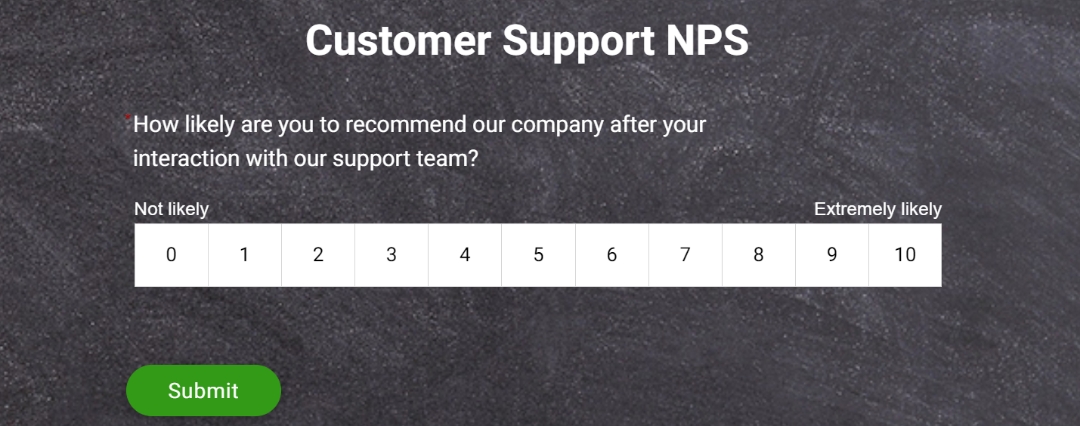
Step 4: Survey Structure and Design
- Keep your survey concise, ideally no more than 5-10 minutes to complete.
- Use a mix of question types, such as multiple-choice, rating scales, and open-ended questions, to gather both quantitative and qualitative data.
- Consider including demographic questions to segment responses and identify patterns among different groups.
Step 5: Choose a Survey Distribution Method
- Depending on your audience, choose the most appropriate distribution channels (email, website, app, etc.).
- Personalize invitations to increase response rates.
- Use reminders to encourage those who haven’t responded.
Step 6: Collect and Analyze Responses
- Regularly monitor incoming responses to ensure the data collection process is going smoothly.
- Set a target sample size to ensure your results are statistically meaningful.
- Use survey software or tools to help manage and analyze responses efficiently.
Step 7: Interpret and Take Action
- Calculate your NPS score and understand what it means in terms of customer loyalty and advocacy.
- Segment your NPS data by different customer segments to uncover insights specific to each group.
- Look for trends and patterns in the qualitative feedback to identify common themes.
Step 8: Follow Up
- For detractors, consider following up with personalized responses addressing their concerns. This can help turn detractors into promoters.
- Use the feedback to prioritize and implement changes that address the issues raised by respondents.
Step 9: Repeat the Process
- Conduct NPS surveys at regular intervals (e.g., quarterly, biannually) to track trends and measure the impact of your improvements over time.
- Use benchmarking to compare your NPS scores to industry standards or competitors’ scores.
FREE. All Features. FOREVER!
Try our Forever FREE account with all premium features!
What Can You Do With Your NPS Score?
Your Net Promoter Score (NPS) is a dynamic instrument that can be harnessed to spark positive transformations within your business. In this section, we will explore the myriad ways in which your NPS score can be leveraged to enhance your company’s performance, customer relationships, and overall success.
Identifying Strengths and Weaknesses
Your NPS score provides a snapshot of how your customers perceive your product or service. By analyzing the score, you can identify specific areas of strength and weakness in your business. For example, a high NPS might indicate that customers love your product but have concerns about your customer support. Conversely, a low NPS could highlight product quality issues.
Customer Segmentation
Analyzing NPS scores by customer segments can provide valuable insights. You may find that certain customer groups have significantly higher or lower NPS scores. This information can guide you in tailoring your products, services, or marketing efforts to specific customer segments.
Marketing and Communication
A high NPS score can be a valuable marketing tool. Promote your NPS score and customer testimonials in marketing materials, on your website, and in social media campaigns. It serves as social proof of your company’s commitment to customer satisfaction.
Customer Loyalty and Retention
A strong NPS score is closely tied to customer loyalty. Satisfied customers are likelier to remain loyal, make repeat purchases, and refer others to your business. Use your NPS insights to build customer retention strategies and reward loyal customers.
Product and Service Development
NPS feedback can directly inform product or service development. Incorporate customer suggestions and feedback into your innovation process to create offerings that better meet customer needs and expectations.
Crisis Management
In times of crisis or negative events, NPS can be an early warning system. A sudden drop in NPS may indicate an issue that requires immediate attention, allowing you to address problems before they escalate.
5 Best NPS Tools for 2024
Here is a comprehensive list of the 5 best tools that will help you create, share, and monitor your NPS:
1. ProProfs Survey Maker
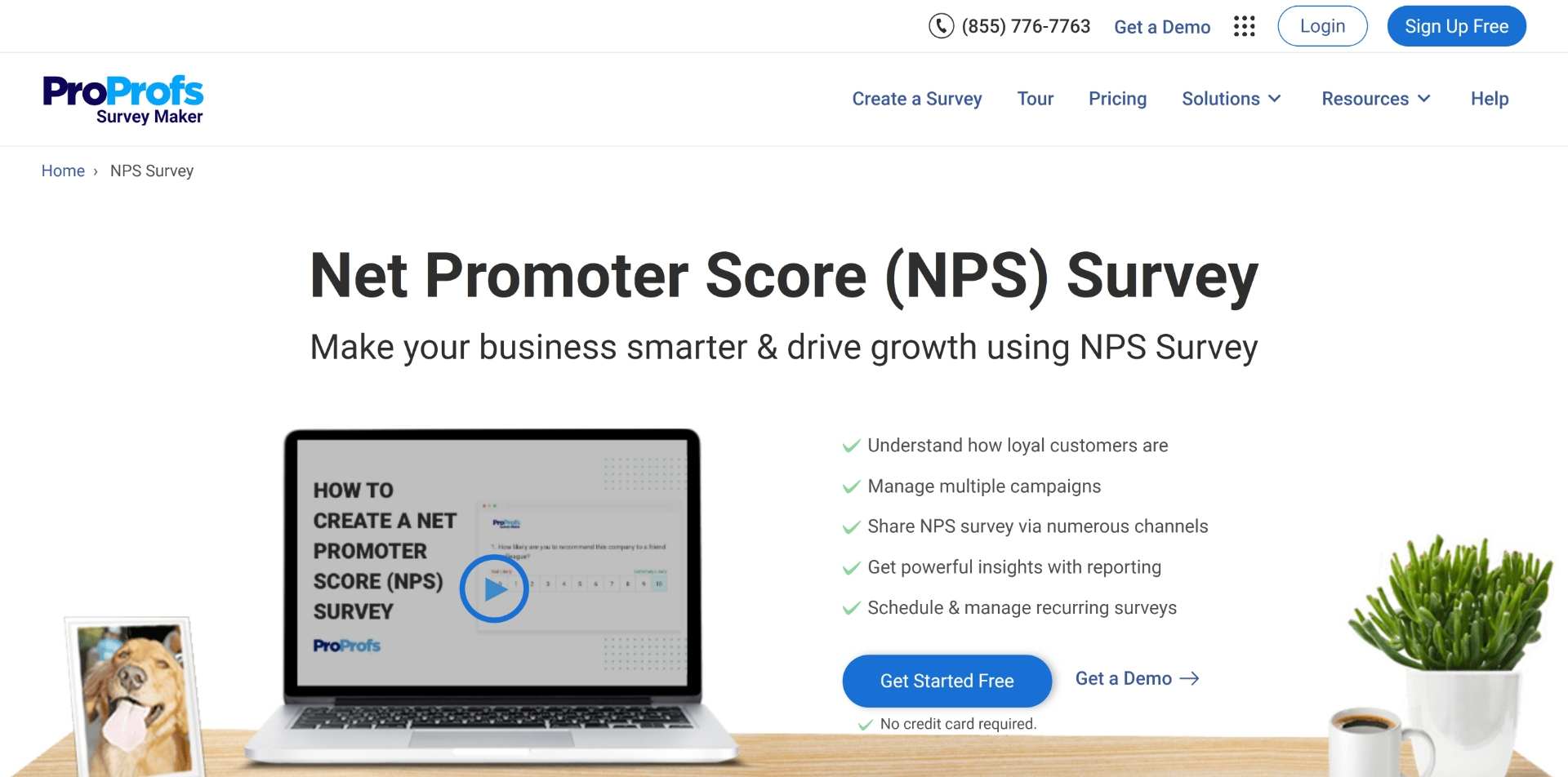
Hailed as one of the best in the market, ProProfs Survey is a robust online survey platform designed to simplify the process of creating and deploying surveys. With a user-friendly interface and analytical prowess, it empowers businesses to gather valuable insights and make data-driven decisions in a matter of minutes.
The tool offers a host of powerful survey features, such as advanced survey logic, 100+ templates, automated analytics, and widespread integrations to make the survey deployment process even easier.
Top Features of ProProfs Survey Maker
- Craft visually stunning surveys in minutes using 100+ customizable templates and question types.
- Easily distribute surveys via email, social media, and links, or embed them on websites to reach your target audience effortlessly.
- Engage respondents with skip logic, branching, and scoring options, tailoring the survey experience based on individual responses.
- Gain instant access to comprehensive survey reports, allowing you to analyze data, identify trends, and make informed business decisions.
- Connect ProProfs Survey with popular tools like Salesforce, Mailchimp, and more, streamlining your workflow and enhancing productivity.
Watch: How to Customize & Add Branding to Your Survey
2. Qualaroo
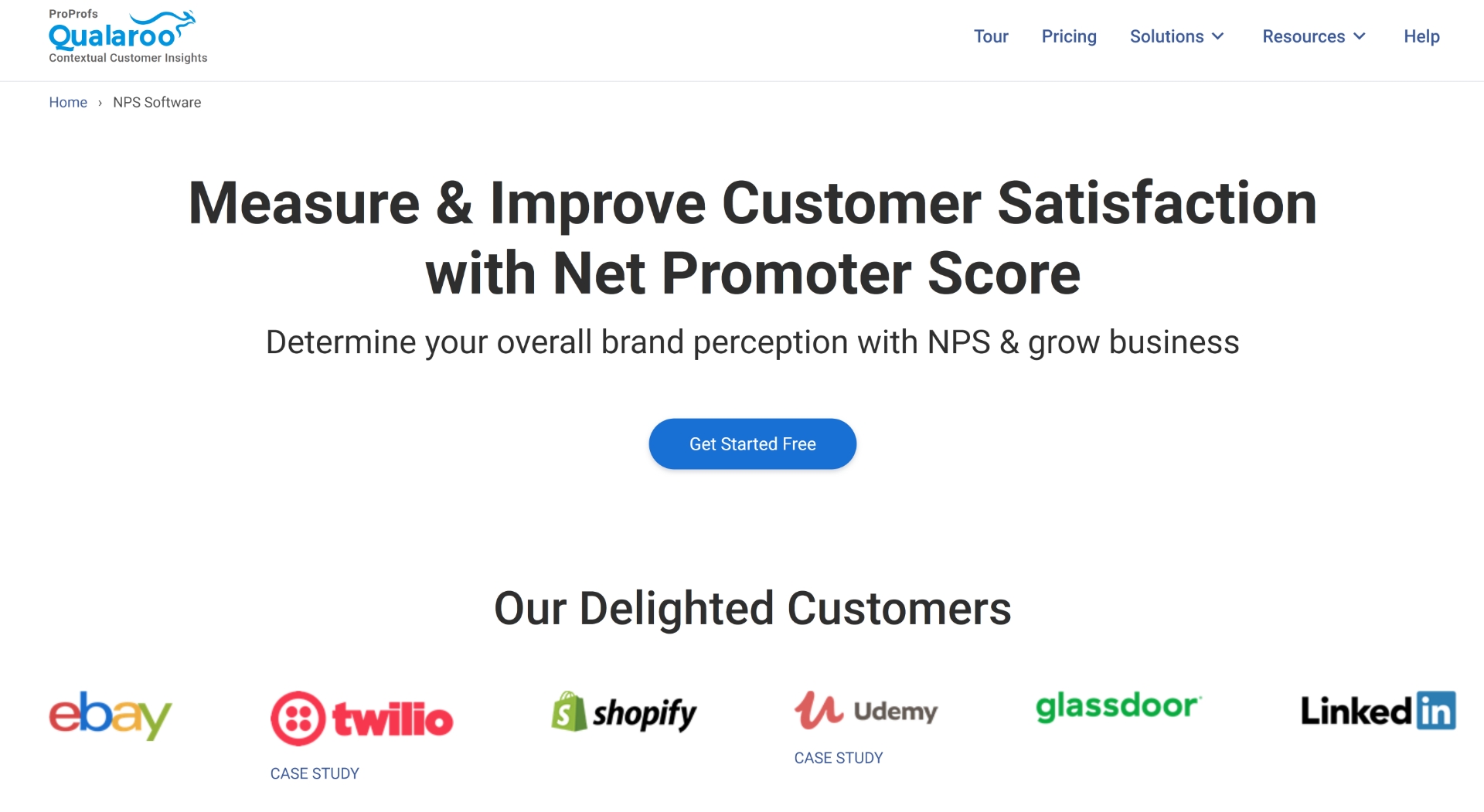
Qualaroo is another cutting-edge user feedback and survey tool crafted to empower businesses with unparalleled customer insights. Its intuitive interface and an array of advanced features, such as drag-and-drop interface, in-app themes, advanced targeting etc., let you launch a survey in minutes.
You can uncover invaluable data on the advanced analytical dashboard with just a few clicks, enabling you to enhance user experience and fuel substantial business growth.
Top Features of Qualaroo
- Seamlessly connect with website visitors through strategically targeted surveys, capturing their thoughts and opinions at crucial touchpoints.
- Dive deep into user behavior by triggering surveys based on specific actions, such as scroll depth, click patterns, or exit intent, to gain nuanced insights.
- Harness the power of advanced targeting capabilities to tailor survey experiences to distinct user segments, delivering a personalized touch that resonates.
- Delve into comprehensive analytics and reporting tools that dissect survey responses, highlight trends, and equip you with the knowledge to drive informed decision-making.
- Integrate effortlessly with your existing technology stack, including CRM systems, analytics platforms, and marketing automation tools, amplifying your productivity and streamlining workflows.
3. Delighted

Delighted’s NPS software provides businesses with a comprehensive solution for running an NPS survey program. The greatest advantage lies in its ability to distribute surveys through various channels in 30+ languages, ensuring a global reach.
Whether you’re surveying customers or employees, you can choose to personalize the survey questions to fit your specific needs. Additionally, you can use open-ended follow-up questions to uncover the underlying reasons behind their ratings.
This allows businesses to truly understand their audience and make informed decisions based on customer and employee feedback.
Top Features of Delighted
- Seamlessly collect customer feedback through surveys across various channels, including email, web, and SMS, to gain a holistic view of customer sentiment.
- Gain instant access to real-time, actionable insights with visually engaging dashboards and reports, allowing you to monitor satisfaction trends and make data-driven decisions.
- Tailor surveys to your brand’s unique needs by customizing question formats, branding elements, and language to create a personalized experience for your customers.
- Automate follow-up actions based on survey responses, triggering workflows such as alerts, notifications, and ticket creation to ensure timely resolution of customer issues.
- Integrate Delighted CSAT with popular tools like Zendesk, Slack, and Salesforce, enabling effortless data synchronization and enhancing your customer support operations.
4. Survicate
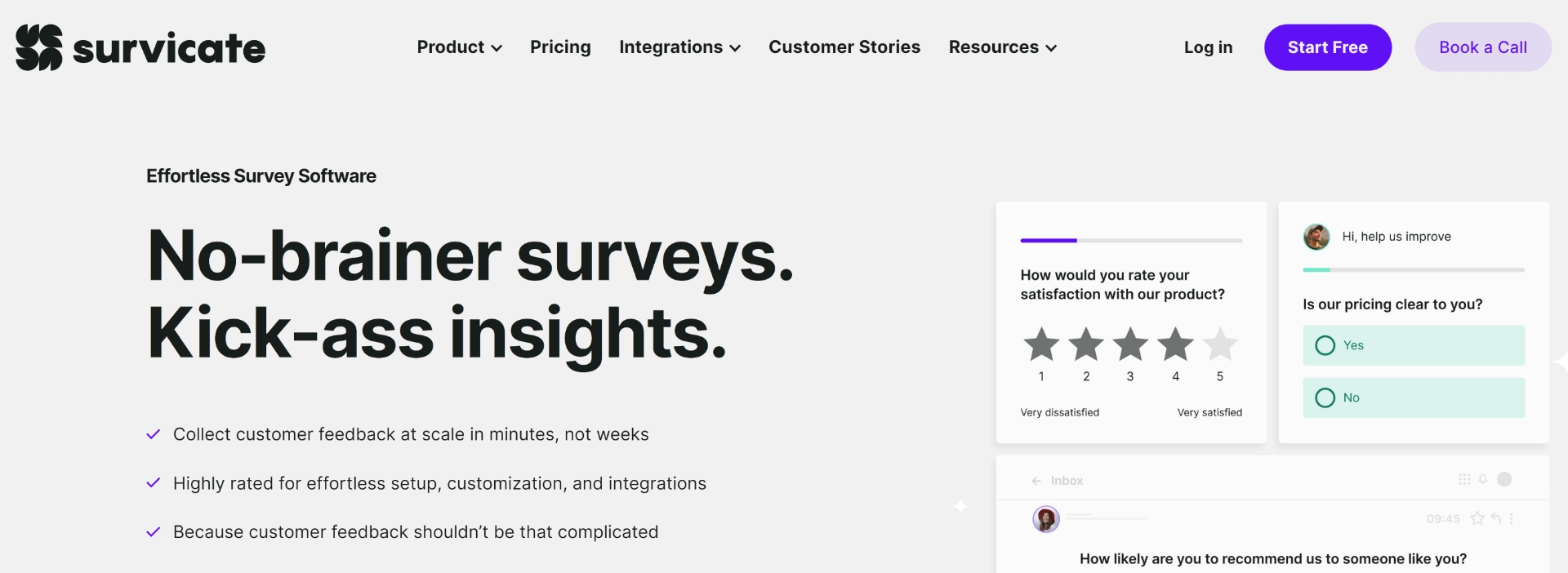
Survicate is a powerful customer insights tool that empowers businesses to understand their customers and optimize their strategies accordingly. The tool enables you to effortlessly capture and review survey responses, including those left incomplete by respondents.
With Survicate, you have full control over customization and branding. Personalize your surveys by adding your company logo, selecting unique colors, and utilizing custom CSS to create visually appealing survey experiences!
Top Features of Survicate
- Engage with your audience through targeted surveys, feedback widgets, and on-site surveys to capture valuable insights that drive meaningful improvements.
- Customize surveys with ease using drag-and-drop functionality, allowing you to create visually appealing and interactive surveys that align with your brand identity.
- Effortlessly target specific audience segments and trigger surveys based on user behavior with advanced targeting and triggering, ensuring you collect feedback at the right time and from the right people.
- Dive into comprehensive analytics and reporting tools to analyze survey responses, uncover patterns, and gain deep insights into customer preferences, needs, and pain points.
- Integrate Survicate with popular platforms like Salesforce, HubSpot, and Google Analytics to enrich your existing data and streamline workflows.
5. Hotjar
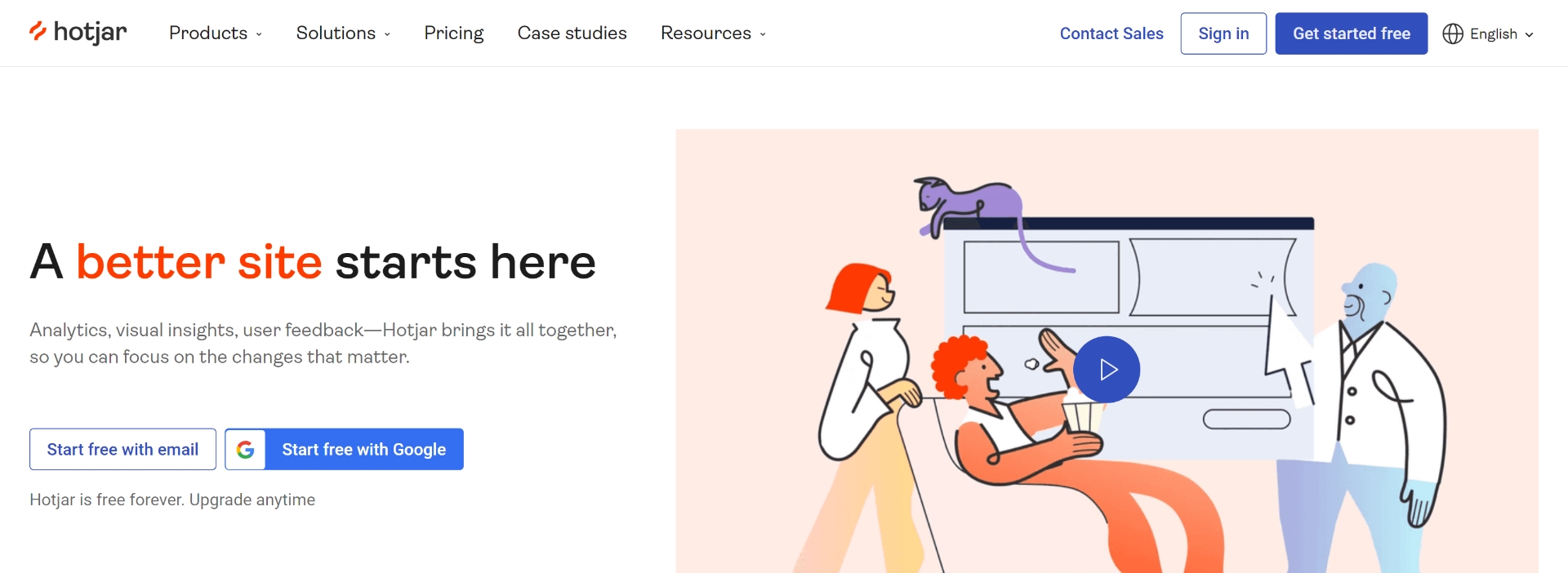
Hotjar is yet another efficient survey tool that lets users easily distribute NPS surveys on their website or via email. It enables you to gauge the likelihood of a customer recommending your products, services, or brand through precise NPS survey results.
With Hotjar, you have the flexibility to ask follow-up questions based on your respondents’ initial feedback, gathering deeper and more valuable insights.
Moreover, you can track NPS trends over specific timeframes, such as 30 days, 90 days, or 12 months, according to your specific needs.
Top Features of Hotjar
- Visualize user interactions through heatmaps, session recordings, and conversion funnels to see exactly how visitors navigate and engage with your website.
- Understand user feedback through customizable surveys and feedback polls, gaining valuable insights into user preferences, needs, and pain points along the way.
- Identify conversion bottlenecks with form analytics and funnel visualizations, pinpointing areas of improvement to optimize your conversion rates.
- Analyze user behavior by segmenting visitors based on specific actions, such as clicks, scroll depth, or time spent on a page, providing you with targeted insights for tailored optimizations.
- Collaborate with your team by sharing and analyzing user feedback and recordings, fostering a collaborative environment for data-driven decision-making.
Enhance Loyalty With a Robust Feedback System
Although conceptualized a decade ago, NPS still remains one of the most reliable ways to measure your customer loyalty and, to an extent, your brand performance. If used correctly, NPS surveys are a powerful tool that can revolutionize your understanding of customer happiness and drive business growth.
Launching a robust NPS survey program can become the quickest way to know the ‘why’ behind your users’ actions, where you are falling short, and what aspect of your brand you should focus on the most.
Aided by an intuitive tool like ProProfs Survey Maker, the chances of your NPS surveys being a success improve exponentially, as it not only lets you craft your survey questions with free-flowing creativity but analyzes the results like a pro using one of the most advanced technologies available as well!
So, on a scale of 1 to 5, how willing are you to recommend us to your peers?
Use the trial version and let us know!
Frequently Asked Questions
What is the Net Promoter Score NPS questionnaire?
The NPS questionnaire typically consists of one key question: “On a scale of 0 to 10, how likely are you to recommend our product/service to a friend or colleague?” It may also include an optional open-ended question for additional feedback.
What is a good NPS survey score?
A good NPS score typically falls within the range of +50 to +70. Scores above +70 are considered excellent, while scores below +0 may indicate significant issues.
How to do a Net Promoter Score survey?
To conduct an NPS survey, you need to ask customers the NPS question mentioned above. Afterward, categorize respondents into promoters (9-10), passives (7-8), and detractors (0-6).
Calculate the NPS by subtracting the percentage of detractors from the percentage of promoters.
Use the formula:
NPS = % Promoters – % Detractors
What is the ultimate NPS question?
The ultimate NPS question is: “On a scale of 0 to 10, how likely are you to recommend our product/service to a friend or colleague?” This question is at the core of the NPS methodology and provides the primary data for calculating the NPS score.
 Tips
Tips
We’d love to hear your tips & suggestions on this article!
FREE. All Features. FOREVER!
Try our Forever FREE account with all premium features!


 We'd love your feedback!
We'd love your feedback! Thanks for your feedback!
Thanks for your feedback!






